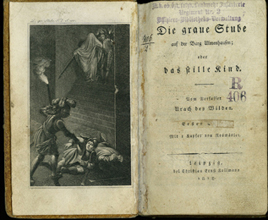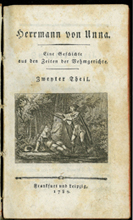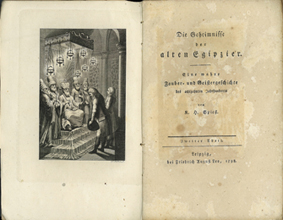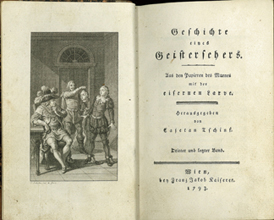Top>Research>German Gothic Novel
 Index
Index

Nobuharu Kamei [Profile]
Education Course
German Gothic Novel
Nobuharu Kamei
Associate Professor of German Literature and Comparative Literature, Faculty of Economics, Chuo University
1. The Terminology〈German Gothic Novel〉
In late 18th century Europe, with technological improvement of the letterpress, advancement in reading skills across a wide range of classes, and developments in distribution methods such as commercial rending libraries and book peddlers, an unprecedented number of entertainment novels were published. The mass production/mass consumption era in print media has began. One of those major genres was〈Gothic Novel〉, which first appeared with The Castle of Otranto (1764) by Horace Walpole from England. Gothic novels are novels set in haunted medieval castles where beautiful and innocent heroines are threatened by villains or depraved monks, which became the roots of horror fiction and suspense fiction. Also,〈Goth〉, which is becoming a new aesthetic style centered on modern fashion, can trace its roots back to here.
Since Dorothy Scarborough's The Supernatural in Modern English Fiction (1917) and Montague Summers' milestone work The Gothic Quest (1938), many studies have examined English gothic novels from various viewpoints.
The same type of the English gothic novel, which was also very popular in German-speaking countries at the time, is called〈Schauerroman〉(horror novel) in German literature. That is because an effect to relay a bloodcurdling sensation can be seen in all their texts. It was pointed out at an early stage that Schauerromane are by no means inferior to its English counterpart in terms of quality and quantity, and both are closely interrelated in many areas. However, compared with English gothic novels, unfortunately Schauerromane received little attention, even in Germany, resulting in there being scant research on the topic. A change in this situation began in the mid 1960s when research started to appear on〈Trivialliteratur〉(popular novels). This developed even further with research by Canadian Michael Hadley. In Undiscovered Genre (1978), he gave a comprehensive commentary on this genre, and in saying that〈Schauerroman〉should be taking up for discussion in international research, he proposed the all-encompassing English term〈German Gothic Novel〉.
Based on this trend, I have investigated〈Schauerroman〉, namely works that come under Hadley's generic distinction of〈German Gothic Novel〉, and endeavoured to produce research taking a general survey of the genre. My research looks at, not only the relationships between the varied sub-genres in German Gothic Novels and German romantic novels, but also the relationship between England and Germany surrounding gothic novels and romantic novels, which are far more comprehensive and complicated than what has been taught in literature history until now. My research is decisively post-Hadley, and it is certain that we have slowly been moving toward an understanding of the genre outlined in Hadley's research. Also recently, we have finally seen a move toward serious research in this field, including research on individual authors, even among German literature scholars. However, we can't say that there has been sufficient progress in that work. I have taken on part of the responsibility for that work, while at the same time, I am attempting to fill in the vacuum of late 18th century German literature history study in Japan.
2. Types and characteristics of German Gothic Novel
So, what specific literature sub-genres are there in German gothic novels? These can be divided into three main types:〈Ritterroman〉(Chivalric Novel), 〈Räuberroman〉(Novel of Banditry), and〈Geisterroman〉(Novel of Spirits).
Ritterromane are mainly set in medieval times and are so-called popular historical novels. As the name suggests, these stories tell adventures of knights dressed in armour. The backdrop of a distant past provided the writers with a site in which they could freely use their imaginations. The seven volumes of Leonhard Wächter's Sagen der Vorzeit (1787-98) and Herrmann von Unna (1788) by Benedikte Naubert are important forerunners for this genre.

Heinrich August Kerndörffer, Die graue Stube auf der Burg Ulmenhausen (1818), frontispiece and title page with illustration

Benedikte Naubert, Herrmann von Unna, vol.2 (1789), title page with illustration
Räuberromane depict the activities of heroic bandits modeled on the main character in Friedrich Schiller's Die Räuber (1781), or tell true criminal accounts of the cruel acts of the real bandits in the same period. Either case, hostile feelings toward corrupt secular and religious order and power are stirred up in an unreserved manner. Works representative of this genre include Rinaldo Rinaldini (1799) by Goethe's brother-in-law Christian August Vulpius, and Heinrich Zschokke's Abällino (1794).
Geisterromane are novels that take up the central theme of supernatural phenomena such as necromancy, curses and demonic possession. Two forms are used in dealing with the supernatural; supernatural which is taken to be real within the stories, and rationally explained supernatural. In Das Petermännchen (1791) by Christian Heinrich Spieß, starting with the title role Peter, a devil's servant, many 'real' supernatural beings appear. On the other hand, in works such as Schiller's Der Geisterseher (1789) and Carl Grosse's Der Genius (1791-95), the supernatural mysteries are either made as a part of conspiracy by a secret society, or an intentionally designed device that should warn both the main character in the novel and the actual reader of the dangers of becoming unhealthily absorbed or indulged in a transcendental world.

Christian Heinrich Spieß, Die Geheimnisse der alten Egipzier, vol.2 (1798), frontispiece and title page

Cajetan Tschink, Geschichte eines Geistersehers, vol.3 (1793), frontispiece and title page
The invasion of supernatural elements into the realm of reality, whether it is finally explained or not, constitutes one of the axes of gothic novels. More than anything, this genre, with mystery and fear as its theme, was a literature that profited from that. However, those stories, being literature of the Age of Enlightenment, existed firmly on the premise of the knowledge that, in the real world, the menace does not exist beyond human intelligence. Accordingly writers from the century of reason confronted the dilemma between rationalization and the pursuit of mystery; that is, how to deal with supernatural elements in their novels was always a major problem to them.
In the genre〈Geisterroman〉, there are a numerous number of works such as those written by Austrian Joseph Alois Gleich.

Joseph Alois Gleich, Die Blutende Gestalt mit Dolch und Lampe oder die Beschwörung im Schlosse Stern bey Prag (1799), title page with illustration
3. Actual anxiety and Gothic Novel
Gothic novels, which were written over several decades from the late 18th century to the beginning of the 19th century, created a new relationship between readers and literary texts. The readers increasingly made to identify themselves with the fictional characters to the extent that they strangely proceeded on their own initiative and took possession of the suffering and anxiety as their own. This can be understood as the readers' remedy to cope with the actual anxiety that was aroused through social change such as the French Revolution. The readers' demand for terror was responded by the steady publication of similar stories. The desire to find pleasure in fictitious terror became unbridled, and the soothing of the terror presented in the novels became an idealistic form of pleasure for avid readers. From The Castle of Otranto to the exorbitant number of works published in the 1790s, in both England and Germany, the readers continuously simulated an endless upsurge of artificial terror on the work of fiction. The anxiety of each era always reflects in the literary texts of the times. The conversations between the texts and the readers have repeatedly justified the creation of a new horror genre. This system, from the moment of the creation of Gothic Novel, started to function as the ultimate system to contain actual anxiety. Marquis de Sade, in 'Idée sur les romans' (Preface in Les Crimes de l'amour, 1800), called English gothic novels 'roman nouveau' (new novels). German gothic novels, in the same way as the English works, must be justifiably and adequately recognized as having played that pioneering role.
I have given a simple explanation on German Gothic Novel. As I stated above, this research field in German literature is yet in the developmental stage internationally. Even more, it is almost unknown in Japan. The works that have translated into Japanese are currently only two: Schiller's Der Geisterseher (translated by Professor Minoru Ishikawa, who first introduced this genre to Japan) and Professor Setsuo Hata's translation of Spieß' Das Petermännchen. I am currently attempting to translate Ignaz Ferdinand Arnold's Das Bildniß mit den Blutflecken (1800) and Die doppelte Ursulinernonne (1800), but there are also many other interesting works in German Gothic Novel. At the same time as continuing my research, I hope I can gradually translate and introduce some of those valuable texts to the Japanese Readers.
- Nobuharu Kamei
Associate Professor of German Literature and Comparative Literature, Faculty of Economics, Chuo University - Born in Nara in 1963.
Graduated from the School of Law, Waseda University in 1989. Finished Master's Program of the College of Art, Graduate School at the Nihon University in 1995. Completed Master's Program of the Graduate School of Literature, Waseda University in 1998. Studied at the University of Freiburg in 2002-04. Completed Doctoral Program of the Graduate of Literature, Waseda University in 2005. Became a Doctor of Literature in 2008. After working as reserch assistant in the Institute of Comparative Literature of Waseda University and part-time lecturer at the same university, he took up his current position in 2012.
His recent area of research is German popular fiction around 1800 and German romanticism, especially the works of E.T.A Hoffmann.
Major publications include, German Gothic Novel (Tokyo, 2009), and Mastering German Grammar in 30 Days (Tokyo, 2008).
- Research Activities as a Member of Research Fellowship for Young Scientists (DC1), Japan Society for the Promotion of Science (JSPS) Shuma Tsurumi
- Important Factors for Innovation in Payment Services Nobuhiko Sugiura
- Beyond the Concepts of Fellow Citizens and Foreigners— To Achieve SDGs Goal 10 “Reduce Inequality Within and Among Countries” Rika Lee
- Diary of Struggles in Cambodia Fumie Fukuoka
- How Can We Measure Learning Ability?
—Analysis of a Competency Self-Assessment Questionnaire— Yu Saito / Yoko Neha - The Making of the Movie Kirakira Megane








